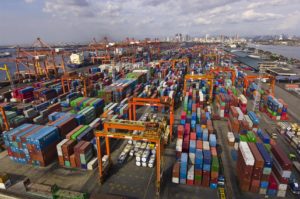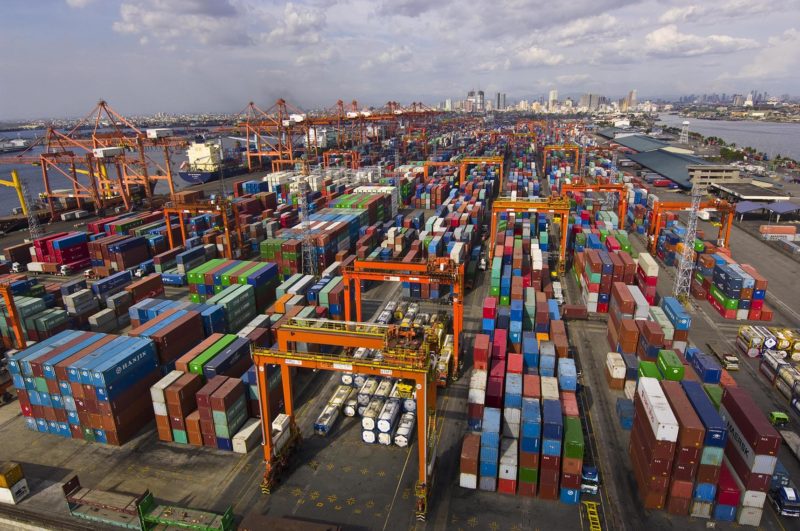
Customs Commissioner Isidro Lapeña said there is no port congestion in Manila’s international terminals, saying yard utilization at Manila International Container Port (MICP) and Port of Manila (POM) is at normal rates of 86% and 88%, respectively.
“Earlier, I went to International Container Terminal Services, Inc. (ICTSI) container yard to inspect and see for myself the alleged congestion at the ports. And I saw that there was no congestion at MICP. Getting the data of yard utilization of MICP, it shows that, at present, it is at 86% and that is within the normal operations of the port,” Lapeña said in a press briefing on September 6.
POM, or South Harbor, on the other hand, has an 88% yard utilization, which Lapeña said is still within the normal operations of the port. BOC in a statement said that as of September 7, no vessels are waiting to dock at South Harbor.
In a press statement on September 4, port operator Asian Terminals Inc. said that as of that date, yard utilization at South Harbor was averaging 76%, with no vessels waiting to dock and berth utilization at a healthy 50%. Crane production was averaging at least 25 moves per crane per hour.
The Philippine Ports Authority (PPA) earlier also said Manila port is not congested. In a separate statement on September 5, PPA said yard utilization at the Manila port—composed of MICP, South Harbor, and Manila North Port—remained at a healthy combined utilization rate of 67%. Combined berth occupancy rate is likewise healthy at an average of 59%, while quay crane productivity is at 24 moves an hour per crane.
According to the Center for the Advancement of Trade Integration and Facilitation, the ideal port optimization is at 70% of capacity. In the paper titled “Study of Container Terminal Planning” by Professor Nam-Kyu Park of Tongmyong University Department of Logistics Management in South Korea and associate professor Branislav Dragovi of the University of Montenegro Maritime Faculty in Montenegro, based on the opinion of terminal operators, a container yard capacity occupancy ratio of 60% is suitable for the smooth workflow of the whole container terminal.
BOC spokesperson and POM district collector Atty. Erastus Sandino Austria earlier told PortCalls there was currently high yard utilization but no congestion at POM, which was due to overstaying empty containers taking up space in the yard, and other factors in the logistics chain that is out of BOC’s control.
The clarifications on port congestion were issued following a statement of Senator Aquilino Pimentel III baring his plan to summon officials of BOC to explain and account for the “slower movement and longer delays” in the release of imported shipments at the Manila ports.
Pimentel, who chairs the Senate Committee on Trade, Commerce and Entrepreneurship, revealed receiving a growing number of complaints from importers, traders, truckers, customs brokers, and overseas Filipino workers associations claiming “worsening port congestion at the Manila Port.”
Lapeña said weather conditions in the Philippines have caused delays in the berthing of vessels and unloading of containers in the yard. He said that, nonetheless, BOC is closely coordinating with the terminal operators to be ready for the influx of cargoes for the holidays.
“The vessels are arriving simultaneously and the terminal operator cannot accommodate all vessels in the berthing area. They have to wait for their scheduled berthing in the breakwater,” he said.
Lapeña said all district collectors have been directed to expedite the release of shipments, especially basic commodities, once containers are unloaded.
According to Lapeña, a memorandum has been issued to all port collectors to expedite the processing of essential food such as rice, sugar, pork, and chicken, and to closely monitor the movement of vessels anchored in the breakwater. This is to aid supply issues caused by artificial shortage.
“We are issuing alert orders on shipments with derogatory reports to balance our trade facilitation and border protection efforts. All shipments found with no irregularities are cleared immediately,” he said.
Alerted general shipments shall be examined within 48 hours, while perishable goods shall be examined within 24 hours from the issuance of the alert order. Shipments found with no irregularities shall be released within 48 hours.
“We are only asking the importers to give what is due to the government and to declare their items accordingly. If they are doing things by the law, we do not have any reason to issue alert orders,” Lapeña said.





